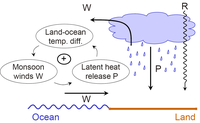
“The agricultural food supply for around two billion people in Asia and Africa depends on the eponymous regularity of monsoon rainfall,” says the lead author Anders Levermann. The name “monsoon” stems from the Arabic word “mausim” for “season”. However, months with extremely scarce precipitation have been observed within monsoon seasons, as in India in 2002, causing economic and humanitarian problems in the affected regions. During the past 11,000 years rainfall in monsoon regions has undergone strong and abrupt changes repeatedly.
The researchers investigated how such irregularities or disruptions of monsoon circulations can come about. “Our analysis shows on the basis of observations that there could be two stable states for monsoon systems and the possibility of abrupt transitions from one to the other,” says Levermann.
The driving force of monsoon systems depends on different air temperatures. In spring, the air over land is warmed up more rapidly than the air over the sea. The warmer air rises and moist and cooler air from the ocean flows landwards and yields precipitation, which has two effects: the rainfall cools the land surface, but also releases latent heat, when water vapour condenses to raindrops. The more moist air is transported landwards, the more latent heat is released through rainfall and the more moist air is drawn towards land. This self amplification, named moisture-advection feedback, sustains the temperature difference and the entire circulation. However, the self-amplification is vulnerable and may lead to abrupt changes in response to relatively weak external perturbations, the authors state.

The PIK researchers now present a conceptual model that captures the self-amplification feedback. The basic equations show that there is a critical value of irradiation from the sun for a monsoon circulation to start. If irradiation falls below the critical value, for instance due to high air pollution, no conventional monsoon can develop. Above the critical value, one state with and one state without a monsoon circulation exist.
This allows for an abrupt transition to occur in one of two different ways. First, climatic shifts can push the system across the critical threshold. The transition would occur from one season to the other and last as long as the climatic shift prevails. The second possibility is abrupt transitions between the two stable states, when the system is – as current monsoon circulations are – in the bi-stable regime above the critical threshold. Within one rainy season weakening of monsoon winds and latent heat release could decrease the temperature difference between land and sea until the circulation is disrupted.
Using the model and observational data from the past 60 years the researchers computed the critical values for monsoon systems in India, China, Bangladesh, West Africa, North America and Australia. “We are working on more precise assessments of the vulnerabilities of monsoon systems,” says co-author Jacob Schewe. Currently, large uncertainties still exist. While global warming would increase precipitation, aerosol emissions, especially in countries like India and China, could reduce monsoon stability. “Oscillations between months with strong and months with extremely weak rainfall could overstrain the people’s capacity to adapt,” says Schewe. Thus, the researchers want to further investigate the risks for abrupt monsoon transitions in the respective regions.
The article “Basic mechanism for abrupt monsoon transitions” will appear in print in a Special Feature of the “Proceedings of the National Academy of Sciences”. The Special Feature contains analyses of eight potential tipping elements in the Earth System and is edited by Hans Joachim Schellnhuber, director of PIK.
Article: Levermann A, Schewe J, Petoukhov V, Held H (2009) Basic mechanism for abrupt monsoon transitions. Proc Natl Acad Sci USA, 10.1073/PNAS.0901414106.
Further reading:
Tipping elements in the Earth's climate system, PIK press release
http://www.pik-potsdam.de/news/press-releases/archive/2008/tipping-elements-in-the-earths-climate-system
Image Source: Image Science & Analysis Laboratory, NASA Johnson Space Center
http://earth.jsc.nasa.gov/
For further information please contact the PIK press office:
Phone: +49 (0)331 288 25 07
E-mail: press@pik-potsdam.de





